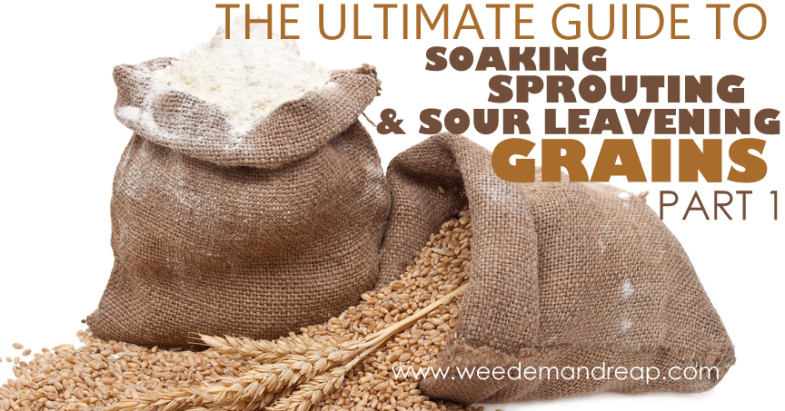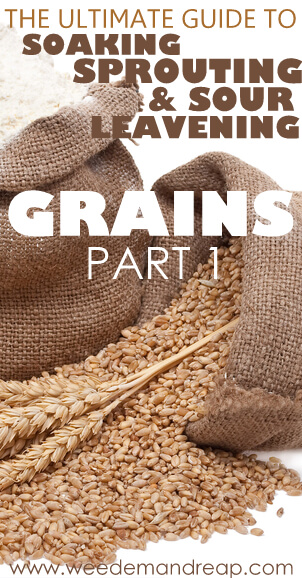Welcome to The Ultimate Guide for Soaking, Sprouting, & Sour Leavening Grains!
For the first part in this series, I’m going give you an introduction to grains. Let’s get the basics out of the way today and then we can dive into how to prepare them properly. Grains are budget-friendly and easy to purchase in bulk. They also store well because of all those anti-nutrients. Grains are divided into two categories — GLUTEN grains and NON-GLUTEN GRAINS.
NON-GLUTEN GRAINS:
Oats don’t have gluten in them, but they are often grown next to wheat fields. This is why gluten-intolerant people purchase gluten-free oats. If you prepare your grains properly, however, you won’t have to worry about the chance of a couple flattened wheat kernels in there and you can just purchase regular oats. Rice, (White or Brown) There are many different varieties of rice. Most diet gurus would lump white rice in with white flour and white sugar and label it as a bad food. The truth is that brown rice carries with it extremely high amounts of phytic acid along with an unhealthy dose of poly-unsaturated fats. Traditional societies knew this and would pound up the brown rice with a mortar & pestle, then sift out the bran to make the minerals more available through the removal of the bran and subsequent phytic acid. It’s also the reason why Asian cultures prefer white varieties of rice. If you choose to eat brown rice, just be sure to soak it well, with an acidic medium for 24 hours. White rice doesn’t really need to be soaked. We like to eat white rice over here, but cook it in nutrient-dense broth to make it a low-glycemic food. Our favorite varieties are Basmati or Jasmine. You can read more on why we choose white rice over brown here. Quinoa is high in protein, and is often a great substitution for meat in dishes. However, its rise in popularity is quickly making it an unsustainable food. We don’t eat a ton of it, and save it for special dishes. I personally like the white quinoa better than the red. Corn is tricky because so much of it is GMO today. You can read why GMO’s are bad here. It’s for this reason that we only purchase organic corn. Traditionally, corn is prepared by soaking in lime water for 2 weeks, and then it is ground up into a paste shaped into tortillas, fried into chips, or mixed with lard and made into tamales. It’s probably the last grain that is being prepared correctly today. Because organic corn is expensive & making homemade properly prepared corn products are time-consuming, we buy in bulk and use it mostly to make popcorn or we grind the corn in our grain mill to make cornmeal to be used in a soaked corn muffin recipe. We purchase organic corn tortillas & chips at our health food store when we need them. Buckwheat, Amaranth, Millet, Kasha, Teff These are other non-gluten grains that are used frequently in side dishes around the world. Feel free to include them in recipes if you want.
GLUTEN GRAINS:
Wheat has a bit of a history. Today’s wheat is a hybrid wheat, but not to be confused with GMO. Hybrid means that a special variety was formed by combining certain characteristics in other grains. It’s a natural method of producing a new variety, but it doesn’t come without its drawbacks. Today’s wheat has a stronger stalk, higher amounts of gluten and more anti-nutrients. This is why many people who have an intolerance to wheat will try older heirloom varieties such as Spelt, Emer, & Einkorn instead. I really love the taste of Spelt, but it’s not as cheap as Wheat. We buy both Spelt & Wheat and switch back and forth depending on our budget. Barley, Kamut & Rye These are other gluten grains that can be used to make bread, although I’ve only had experience with Barley. They are all great to use, just be sure to prepare them properly.
Our Favorite Grains:
I really like the taste of Spelt. I love how it tastes in pancakes, cookies, muffins, etc. It’s a lot lighter tasting than Wheat in my opinion. We eat Basmati or Jasmine rice at least once a week, and occasionally eat quinoa. We’re not a huge fan of oats, but we’ll make granola about once a month. We LOVE corn tortillas, corn chips, etc. We live in Arizona so Mexican food is a must here!
That’s it for today! Check back next week for Part 2 – I’m going to talk all about soaking!



I had these AMAZING pancakes at a restaurant in Los Angeles that were made from kambocha and rice flour. I wanted to recreate them using sprouted jasmine rice flour, but can only find brown rice flour. I’m on a special diet and jasmine rice has the least potential of fermenting in the gut. I was hoping you may know of someone who makes such a flour or if it would be possible to make it myself?
Cheers!
Natalie
Hi Natalie-
I believe the company Blue Orchid has a Jasmine rice flour. They used to sell on Amazon, so you might check there.
Thank you -Bobbi (DaNelle’s Assistant)
Hello! Thank you for your articles – they are full of great information! I have two questions. 1. I got some organic popcorn and I am having a hard time finding how to prepare it! Am I supposed to soak it in lime for two weeks? That seems excessive. I’m also hoping to avoid sprouting because I’ve never done that and am quite intimidated by it. ? 2. I have been soaking/dehydrating nuts for a while now, but I always soak them in salt, whereas you suggest ACV. Is ACV more effective at reducing physic acid? All I’ve ever seen before suggested salt. Thank you so much for your help! It’s hard to keep the kids away from the unsoaked goodies!
Hi Amanda-
Soaking in salt or ACV is pretty much the same. So, whatever your preference is go for that.
As for soaking popcorn, I have never done that, so I can’t tell you anything about the lime.
However, corn is fairly low in phytic acid, so popcorn in moderation is probably fine, even if not soaked. Plus, when it is eaten with melted butter, the saturated fats help mitigate the effects of phytic acid.
Best of luck with your popcorn!
Thank you -Bobbi (DaNelle’s Assistant)
OMG, I’m so glad I found you! You are amazing. I love love love everything on your blog! I just saw this on Pinterest and have been exploring. I already buy some sprouted grain flour but I had no idea I could so easily soak regular organic white flour. My husband eats bread like it’s going out of style and he doesn’t like “healthy ” bread, nor can we afford it. This will be a lifesaver! I’m going to be using a bread maker because I have two little children and lots of brain fog and fatigue so no energy to bake bread by hand. Any drawbacks I should know about? Thank you so much for doing this blog!!!!!
thanks for this post. i don’t really see anything regarding SPROUTING the white basmatic rice after soaking it. do you recommend that and how long should I sprout it? how long should it soak? thank you!
Hi Katie,
I would treat white basmatic rice the same as white rice as far as sprouting! 🙂
Hi Katie,
I would treat white basmati rice the same as white rice as far as sprouting! 🙂
I’m very happy to discover this web site. I want to to thank you for your time due
to this fantastic read!! I definitely loved every little bit of it and I have you saved to fav to look at new stuff on your blog.
Thanks! You’re welcome!
Great info. We use whole wheat/WW flour to make roti – Indian food. But I am trying to reduce the phytic acid in our food to prevent dental decay in my kids teeth and mine. If I add vinegar or lime juice in my dough made with WW flour and water, will be break the phytic acids? Looking forward to your reply.
Hi Rima,
Yes it will! They are both acidic mediums:)
Great info, what should we soak brown rice in? Can I soak a large amount then freeze it, when I’m ready to cook with it? Do you know if costco
has good white rice? I also have a 10 bag of einkorn flour I’d like to use, but I’m nervous about it. My son measured a 1 on blood testing for wheat sensitive. 1 low 4 high. And I’d like to make some bread a lot of gf choices aren’t very healthy for you.
I’m covering non-gluten grains in the last part of this series and I’ll be sure to address that then:)
Love your info DaNelle, I noticed that the link under Corn for why GMO is bad is missing. Please keep up the good work. I plan to share this with family members far and wide!
Thanks for the heads up! The link is fixed now:)